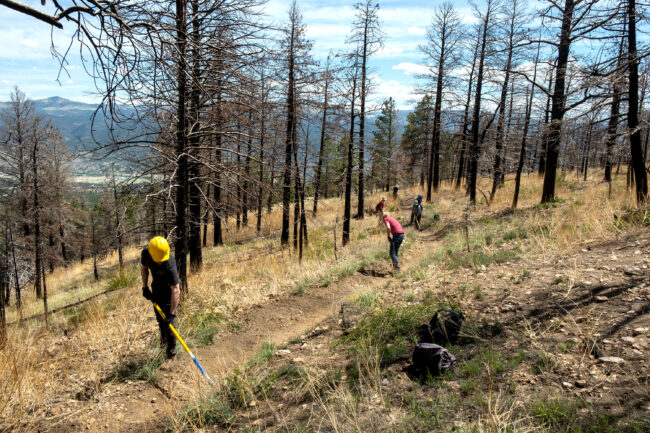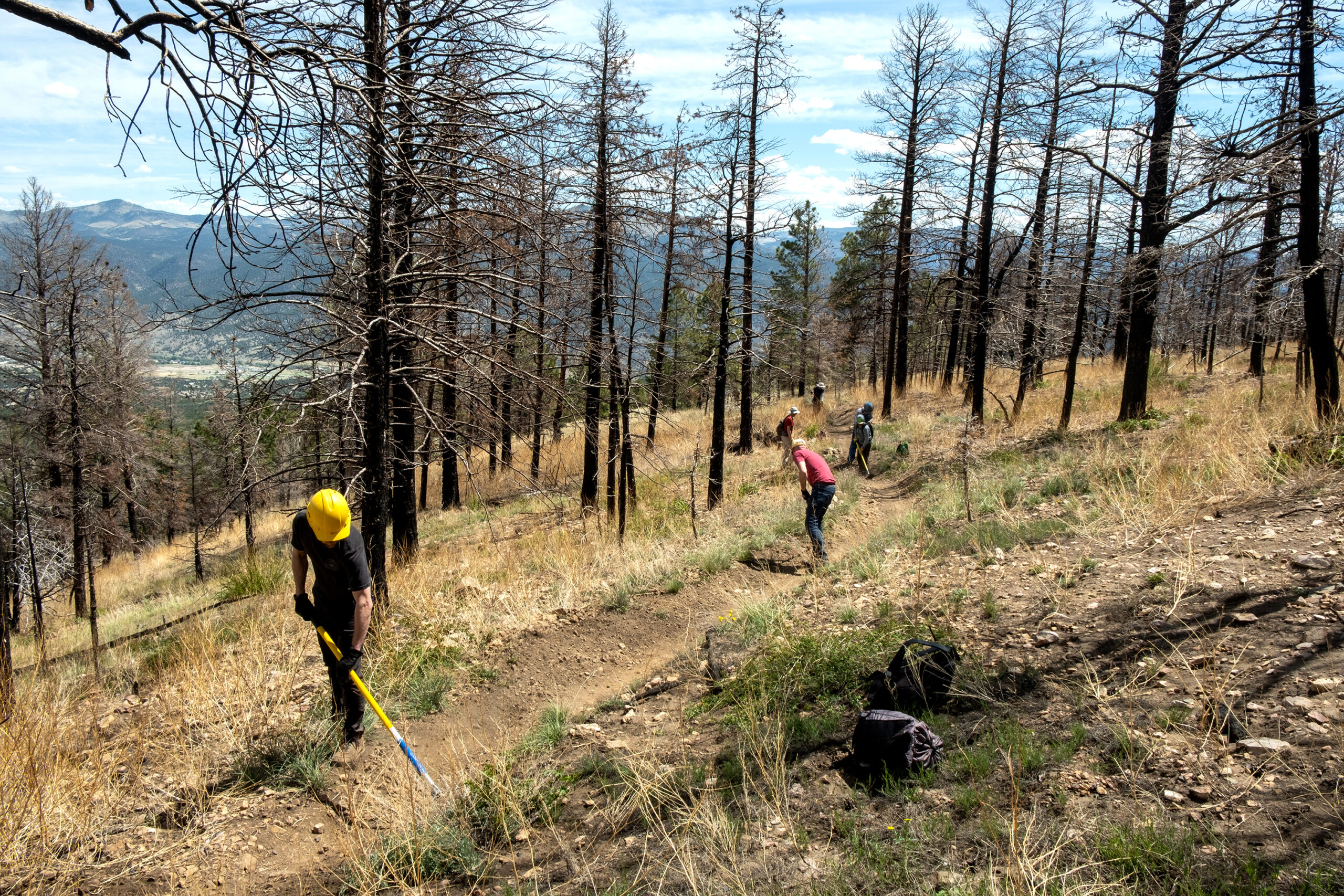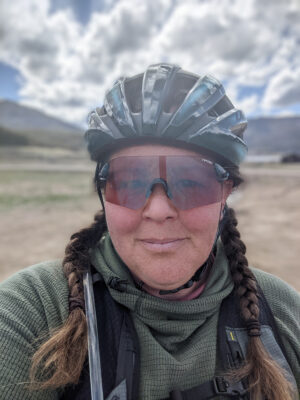
CENTRAL COLORADO HAS BECOME a mecca for outdoor enthusiasts and is known for being welcoming and accommodating — a necessity of embracing a tourist economy. The Upper Arkansas Valley has a reputation for being home to some of the most beautiful, unsullied landscapes in the state. Arriving at trailheads, visitors and locals tuck their vehicles into parking spots, don hiking or biking gear or unload horses, dirt bikes and ATVs to experience the Heart of the Rockies. As these recreators begin their salutations to nature, many have no concept of what happens behind the scenes to keep the trails passable for the endless feet, tires and hooves that traverse them.
Jon Terbush, executive director of Salida Mountain Trails, said, “People see the value in the trails. … They might not see what we are doing out there every single day, the little bit of rocks we are moving. But they understand we are putting a ton of hard work into making the network good for them to go use.”
While many organizations in the Valley have adopted portions of the vast trail system, there are a handful dedicated to keeping these corridors open into nature for all users. Central Colorado Mountain Riders, for example, has more than 200 volunteers who work in conjunction with another 50 volunteers from Salida Mountain Trails to keep a variety of trails in the area open and usable.
Bob Daniel, president of CCMR, pointed out that the mission of the club is to support safe trail use and upkeep. “We go out with chainsaws on our motorcycles and clear trails. It’s good to have [mountain bikers] see us work in conjunction with them.”
Terbush reciprocated the sentiment; “Land managers love to see the level of support between organizations that are stewards of the trails. It’s rare to have that level of partnership, and it’s great that we can work together to get a lot of stuff done.”
While each of these organizations has its own mission for trail care in the area, they have worked together on projects, most recently when sections of the Rainbow Trail were affected by the Decker and Hayden Pass fires. A “gullywasher” came through and washed out about three miles of trail.
Terbush described the damage as a result of plants being burned and the soil having nothing to keep it in place, which is a “deep erosive issue.” Daniel and CCMR started working with the U.S. Forest Service and Bureau of Land Management to address the damaged trail.
CCMR requested an environmental assessment to get approval for the project, Daniel said. The federal agencies sent out biologists, archeologists and other scientists to ensure that the project avoided prehistoric burial grounds and protected sensitive plants and wildlife. Chainsaw work was not allowed until April 16 because the trail runs through critical mule deer birthing habitat, and chainsaw work had to end May 15 to avoid disrupting migratory birds.
Leveraging volunteer work is essential. “We clear trails every spring … with the Salida Ranger District. They … are probably the best OHV crew in the state,” noted Daniel. Given that strong collaborative relationship, CCMR, SMT and the Salida Ranger District came together for the trail repair.
“The Youth Corps came up for a month to clear the trail,” said Daniel, followed by mechanical crews. “We work volunteer cleanup behind. … We clean up anything that might hook on a foot peg. We clear the corridor … 10 feet high” for horseback riders.
Lynn Irwin Camp, CCMR’s membership coordinator, added that collaborative projects like this one benefit everyone who enjoys these multi-use trails, not just motorized users. While the trail work is its own reward, CCMR was also honored with a Public Lands Partner Award, for which they were nominated by the Salida Ranger District, in recognition of an “exemplary partnership for its stunning achievements to protect and preserve public lands and enhance the experiences of visitors.” Irwin Camp said the award “was a big deal for cooperating with land managers and the things we’ve been doing in that regard.”
“As much as we are a tourist-based economy,” Terbush said, “the people who actually live here are extremely generous with their money, and their time, with all of the volunteers we get.”
Each organization has their own future projects. CCMR has formally adopted 54 miles of trail, including several segments of the Rainbow Trail, the Colorado Trail on the Continental Divide, and part of the Monarch Crest Trail.
DudBob Trail in the FourMile Travel Management Area near Buena Vista was recently opened due to the efforts of CCMR, which pursued the project through years of National Environmental Policy Act studies, grant writing, and trail construction.
On the Monarch Crest, their goal is to remove snow cornices to protect the tundra. Daniel described, “When people start riding it and they come across a snowbank [sometimes 6 feet deep], they go out and around, and then two tracks on the tundra will be there for [a long] time — it doesn’t recover.” CCMR has also designed and posted multi-use trail signs to help reduce conflict between user types by raising awareness.
“Other areas have come to us and asked, ‘Can we copy it?’ and we said, ‘Absolutely.” It’s a great asset. It reduces conflict — people say, ‘Oh, there could be a moto on this trail, or a horse,” noted Daniel. CCMR is currently working with Stay the Trail to produce a pamphlet for etiquette and rules for trail use. They also published stickers that say, “Be Nice; Say Hi.” “We’re just trying to reduce the conflicts. When I come by on the trail on my bike, sometimes I hear ‘we just want to thank you [for clearing the trail].’ That makes a big impact.”
Grant writing is a large part of the club’s efforts. The work at the Porter Gulch access point was funded by a Fox Factory Grant. Other grants come from the Colorado Parks and Wildlife OHV Grant. When motorcycles are registered, owners buy stickers for $25 a year. That money creates a fund that awards grants to nonprofit groups, totaling about $6 million a year. This particular fund is for motorized recreation.
Anthony Ware, CCMR vice president, explained, “Just this last year we applied for those grants, and we’re bringing about $250,000 a year into the Valley.”
CCMR also serves the community through volunteer efforts like the Touch the Truck event and 14er Fest. Members also flag and sweep at mountain bike races such as the Grand Traverse. “We remove anything not natural,” said Daniel.
The club also supports Search and Rescue efforts. “Some folks can get in, but they can’t get back out,” Irwin Camp described. “It speaks to the goal of keeping these trails safe.” Members ride the trail and report hazards or issues, and most riders carry a chainsaw or handsaw to clear the trails as needed.
Ware added, “There are certain standards; we don’t just chop it and leave it. I’ve even gotten away from using the term motorized trails and started calling them multi-use trails.”
Salida Mountain Trails, primarily a mountain-bike organization, has a mission of maintaining non-motorized trails. Current volunteer efforts focus on the Arkansas Hills and Methodist Mountain trail systems near Salida. Terbush described a future project with CCMR to work on Monarch Crest Trail down to Highway 285 to the Rainbow Trail.
“It’s a pretty iconic ride,” he noted, adding that it needs some work in order to be safe for a variety of riders. Trails need to be “pedal friendly” and adapted to the current usage.
SMT also focuses on helping educate users on how to recreate responsibly, mirroring Leave No Trace tenants, including the concept of “know before you go,” the idea that the onus is on the participant to educate themselves about the area and applicable regulations.
Working with the Chaffee County Visitors Bureau and the Greater Arkansas River Nature Association, SMT has helped create content and videos about how to recreate responsibly with information ranging from trail usage to cleaning up after pets.
Terbush concluded, “People don’t want to be malicious or have mal-intent — it’s just that people don’t know. It’s incumbent on us as stewards of the trails to try to provide that education.”
So the next time you are at a trailhead, check out the informational signs, read the maps, and make yourself aware of the trail uses. Enjoy a good time in these amazing mountains, courtesy of all the trail stewards. And, be nice. Say “Hi!”
Ways to Support CCMR and SMT
Volunteer for work days.
Register your motorbike.
Support CPW efforts.
Become a member.
Direct donate.
Dine out & Shop:
– The Boathouse Cantina
– Salida Mountain Sports
– Jug Liquors
Visit salidamountaintrails.org.
Visit centralcoloradomountainriders.com.
Pick up a sticker at benicesayhi.com.
Read trail maps.
Know Before You Go at lnt.org.
Starr Hill was raised off the grid in tipis and old mining cabins between Fairplay, Como, Hartsel and Leadville. Now a teacher, she is raising a family of her own and working on a memoir of lessons she learned growing up off the grid.
This article is sponsored by PJ and Merrell Bergin.



